On January 9th we left Acapulco heading to Bahia Papanoa, a small harbor and village approximately 80 miles NW of Acapulco. We arrived in the late evening and we anchored in Playa Escondido opposite to the village of Papanoa. That was a nice and calm anchorage in front of the white sand beach. The day after we moved on the other side of the peninsula, in front of the village, where vacationers spend the weekend enjoying music, restaurants and water games. We spent about 4 days getting rid of a bad flu Sergio got while in Acapulco.

January 9th – Bahia Papanoa
On the 13th we left heading to Bahia de Petatlan where in the SE section of the bay is located a small village called Barra de Potosi. The name comes from the sand bar behind which there is a lagoon that is a wild life refuge, home to a lot of birds species.
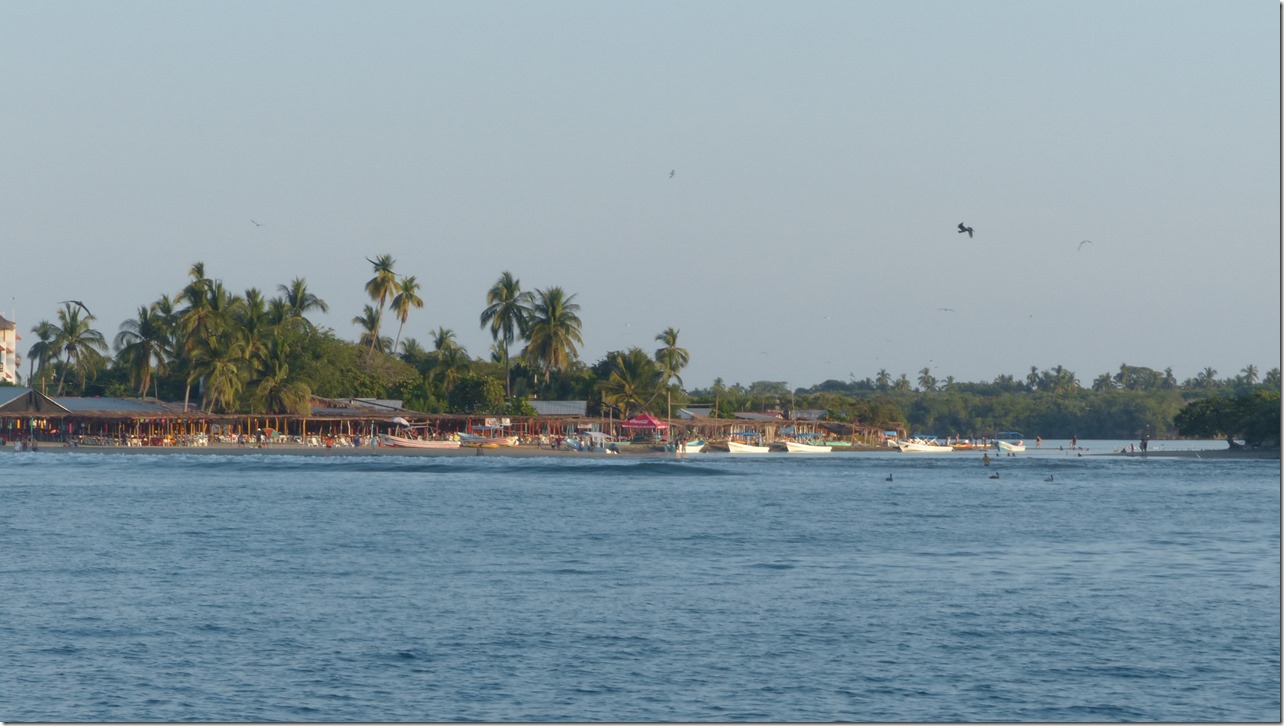
January 13th – Barra de Potosi (right hand side)
On January 15th we motored to the bay of Zihuatenejo; we anchored close to the Playa Los Gatos, in the SE side of the bay.
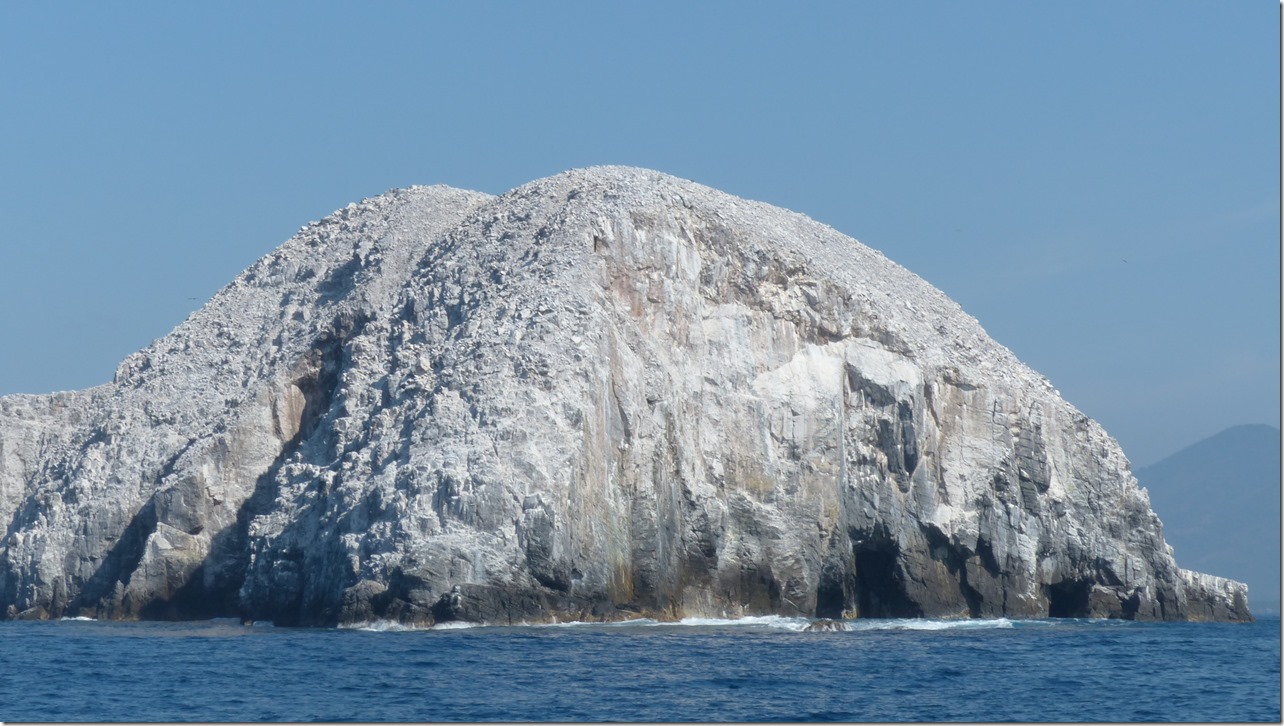
January 15th – Rocas Potosi on our way to Zihuatenejo
We immediately realized that Zihuatenejo is a very alive and turistic city. In fact, the bay was crowded with sailing and power boats, and cruise ships as well!
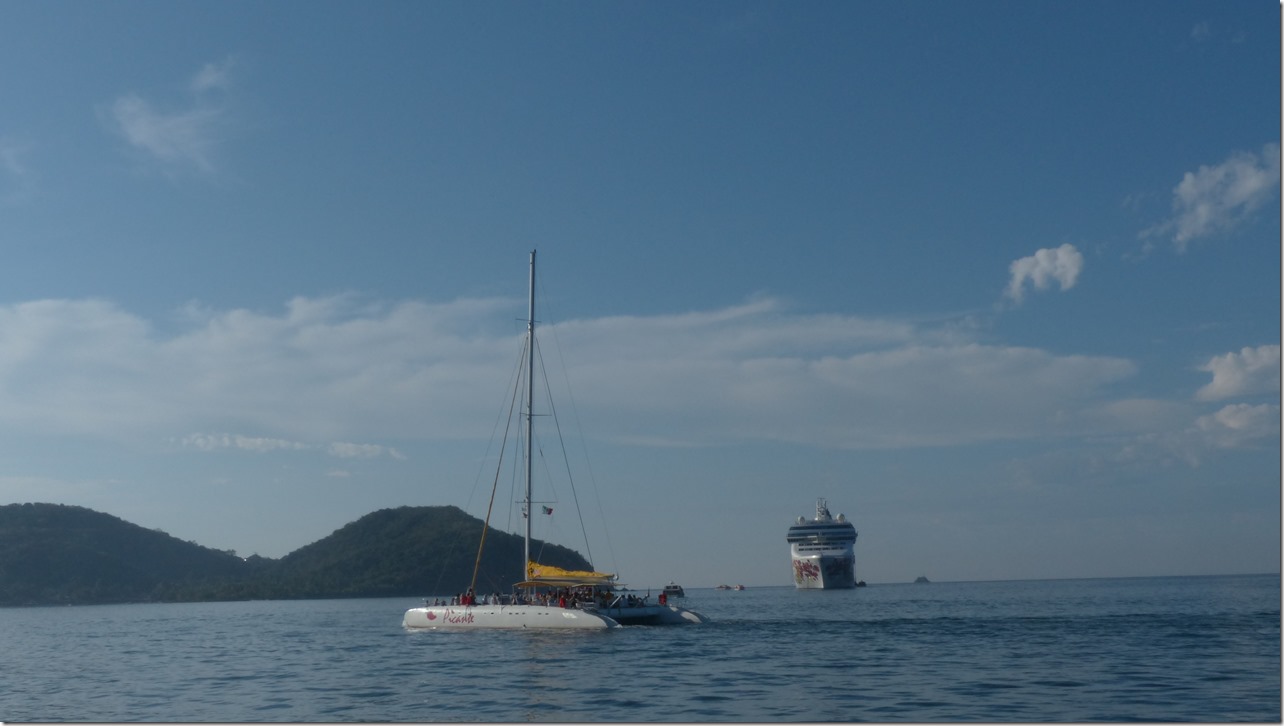
January 15th – Playa Los Gatos is “behind” the catamaran
The day after we decided to anchor on the NW side of the bay, in front of the city dock. We landed the dinghy on the beach with the prompt help of local people who also offered to keep a watch on it. Zihua, as the local call their city, has a nice waterfront walk full of restaurants and shops for the hordes of tourists that fill up the city especially when cruise ships arrive.
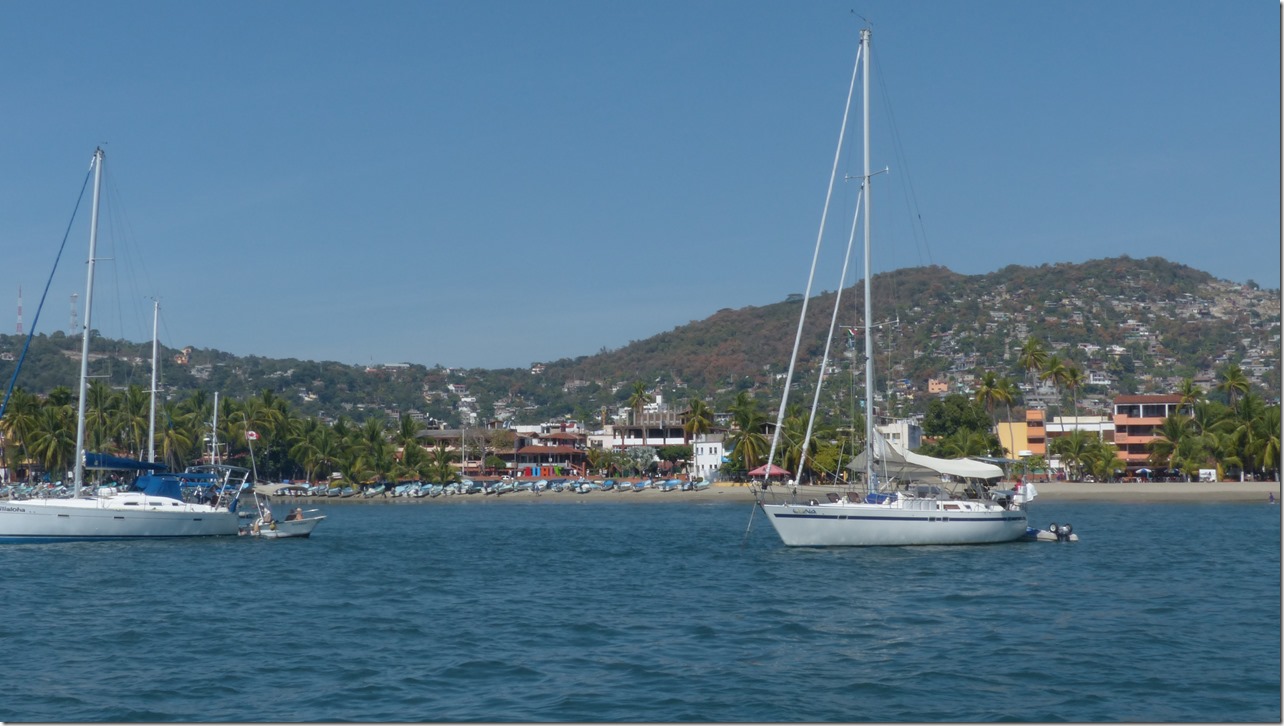
January 16th – The waterfront of Zihuatenejo
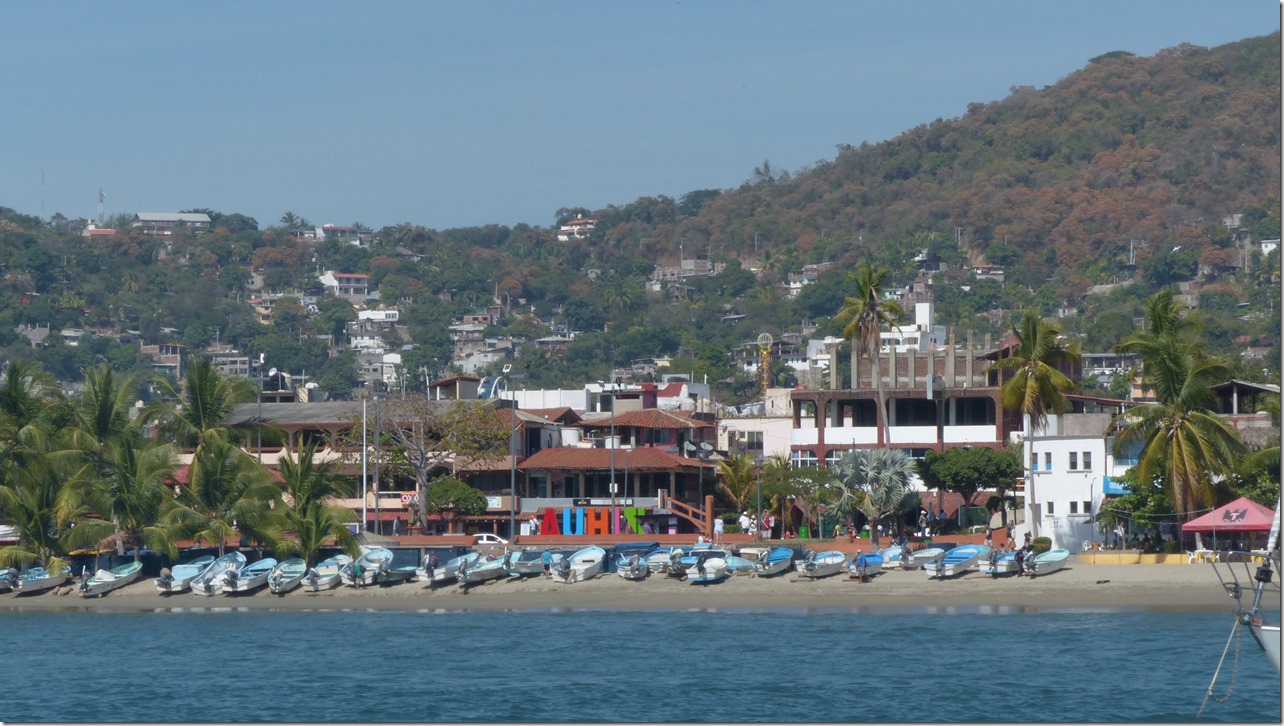
We found a very well equipped supermarket for our routinely provisioning, which included a delicious camembert made in Mexico! We had a great lunch at Leo Mariscos that was recommended by Alison and Dave, a couple of fellow sailors and friends that we met a couple of years ago. After two days we moved back to Playa Los Gatos where we had a nice snorkelling session just twenty meters from the beach.
Few miles further North of Zihuatenejo lies Isla Grande, where we anchored for a couple of days and – on top of the usual snorkeling – we had the chance to get a relaxing 1 hour massage right on the beach.
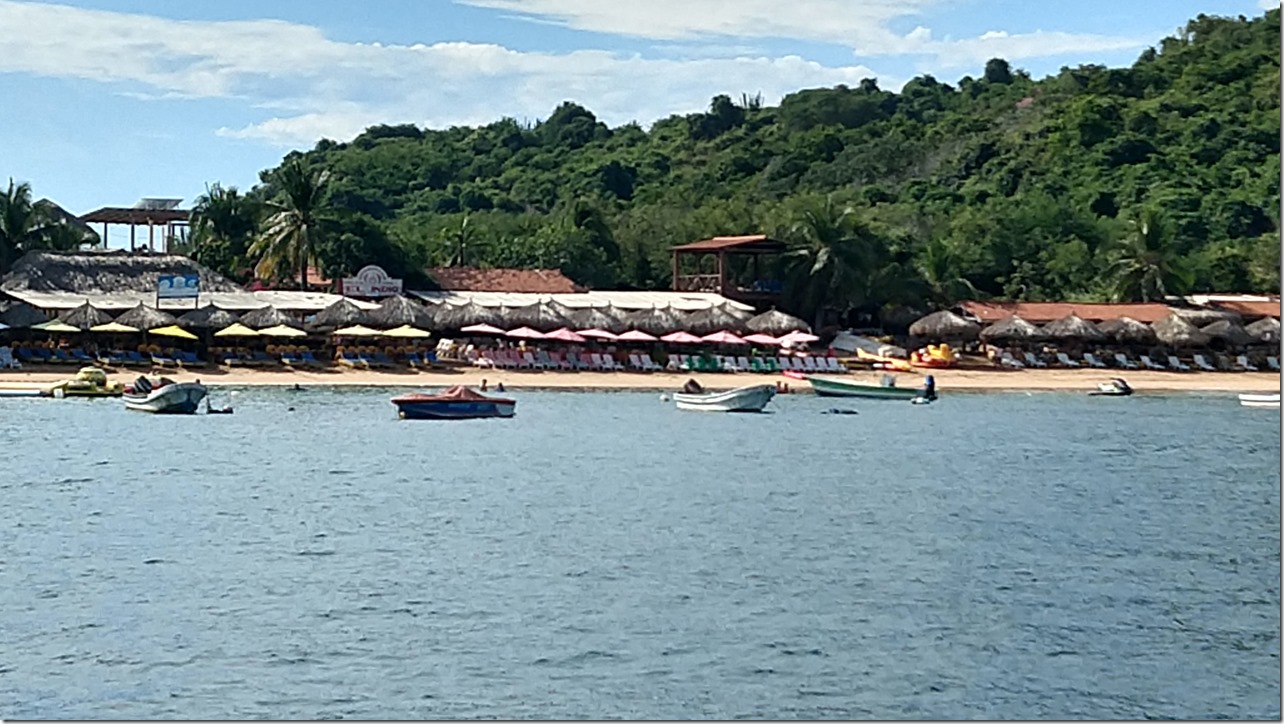
January 18th – Isla Grande, Ixtapa
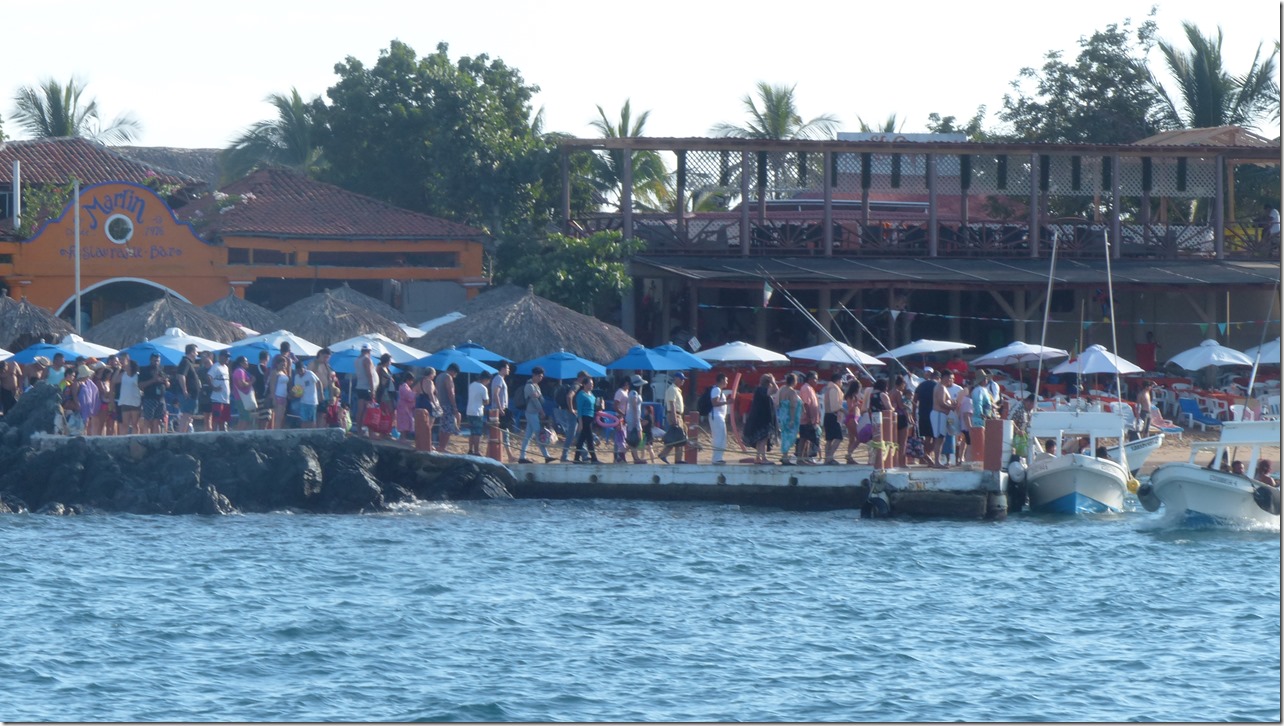
January 19th – Day tourists leaving Isla Grande
While there, we realized that the outboard engine had a problem with the impeller (the cooling water was not circulating), so we decided to get to the close by Marina Ixtapa to have someone help repairing it. The canal to get to the Marina is well marked, however we had to pass through a very narrow stretch of water which is often dredged to keep it clear from the sand that builds up.

January 20th – Entering the Marina Ixtapa
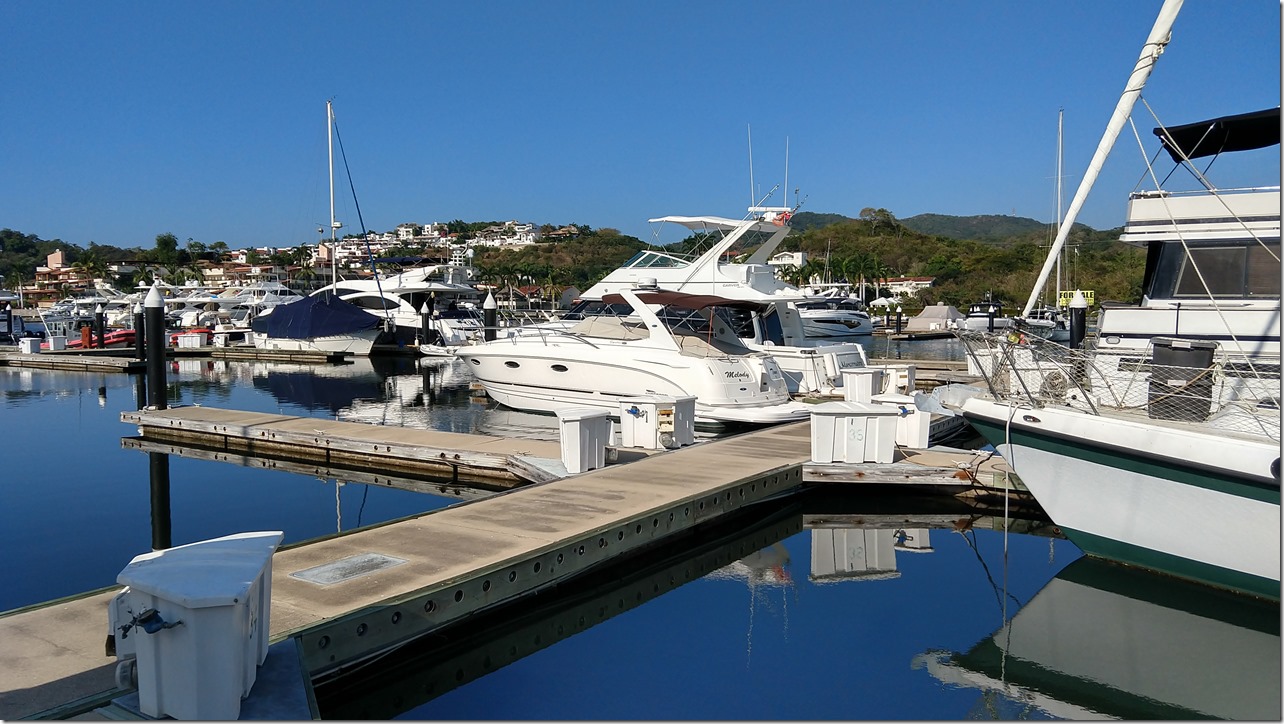
January 21st – Marina Ixtapa
The marina is managed by all women, including the harbour master who kindky welcomed us. It is a nice and comfortable marina with a great shuttle service to Ixtapa and Zihua. Ixtapa is the result of a goverment development project back in the 70s, concurrently with Cancun, but with very different results. In fact, in Ixtapa you can feel some sort of exclusivity and a relatively elegant set of buildings all along its very wide waterfront. We had the chance to visit a crocodile reserve, open to the public, just behind Playa Linda; we were amazed by the number and the size of these crocodiles and by the turtles and iguanas that were all sharing in peace the same habitat.
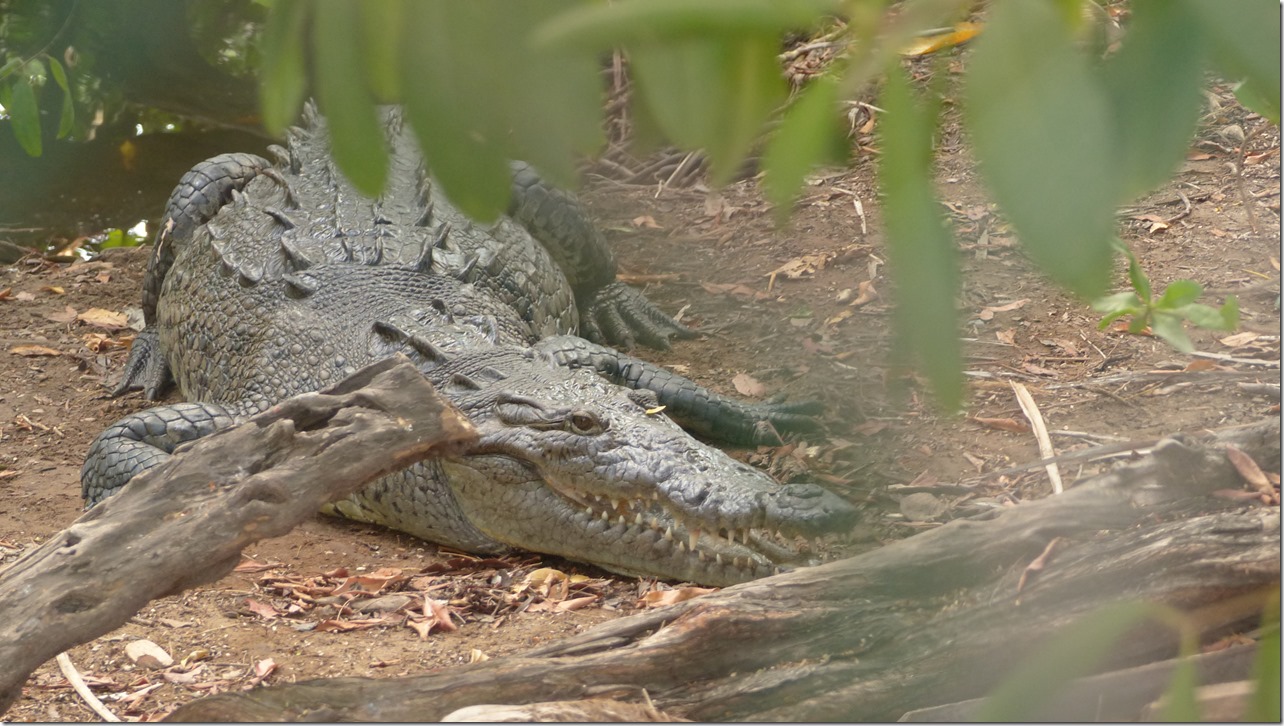
January 21st – Crocodiles reserve
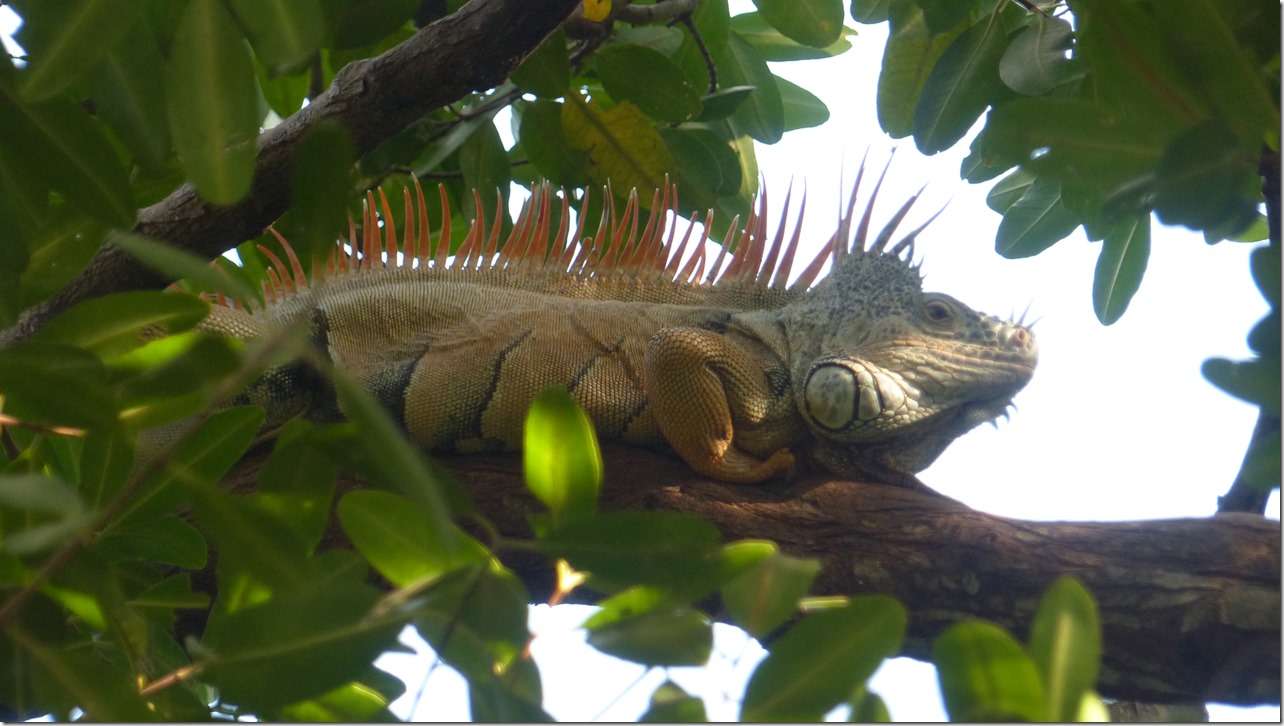
January 21st – Iguana at the Crocodiles reserve
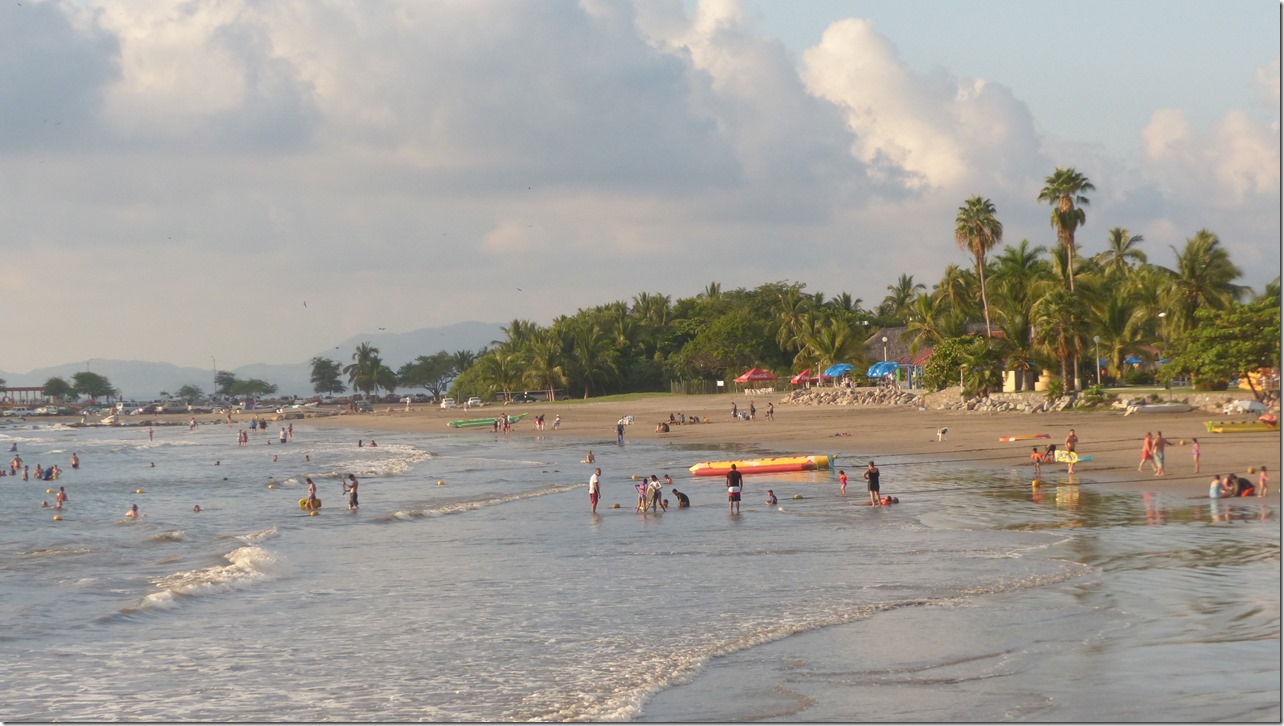
January 21st – Playa Linda
We were able to solve our engine issue thanks to a competent and quite inexpensive local mechanic. Having accomplished our main goal, it was time to leave continuing our trip to North West, heading to Caleta de Campos. Unfortunately it was again a trip dominated by the absence of wind, so we arrived late at night after slowly motoring the whole day.
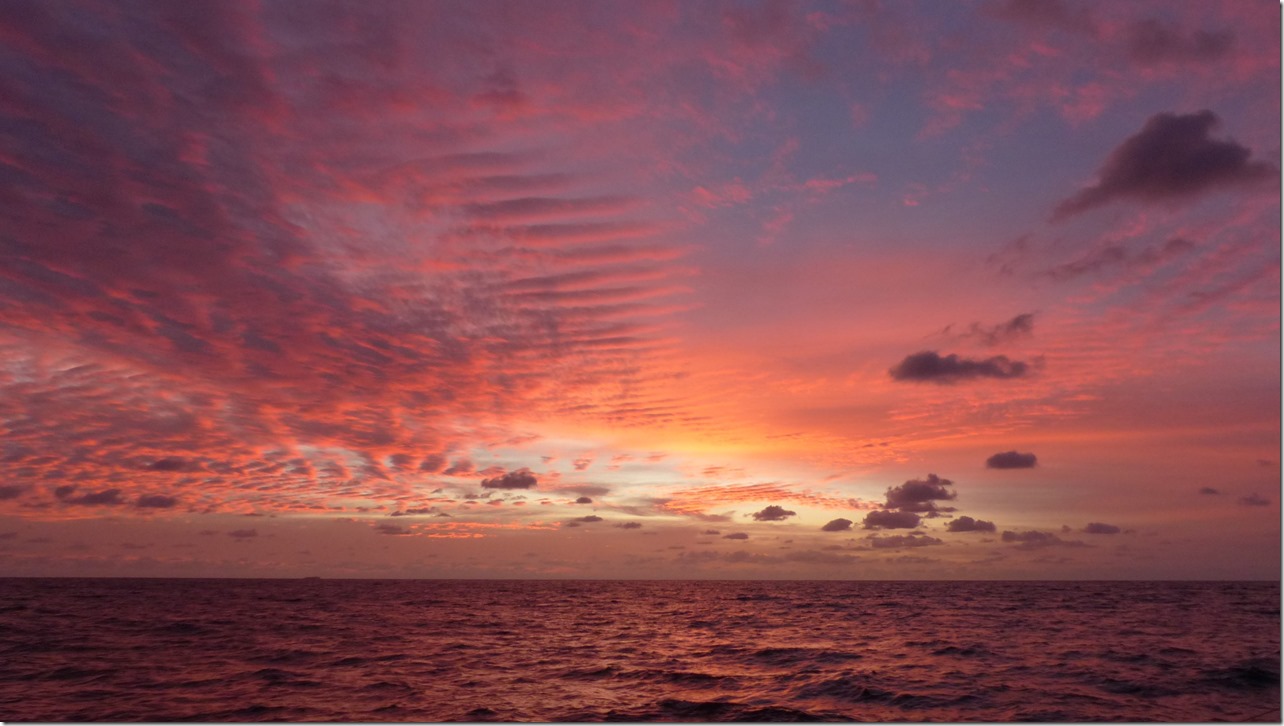
January 23rd – Caleta de Campos
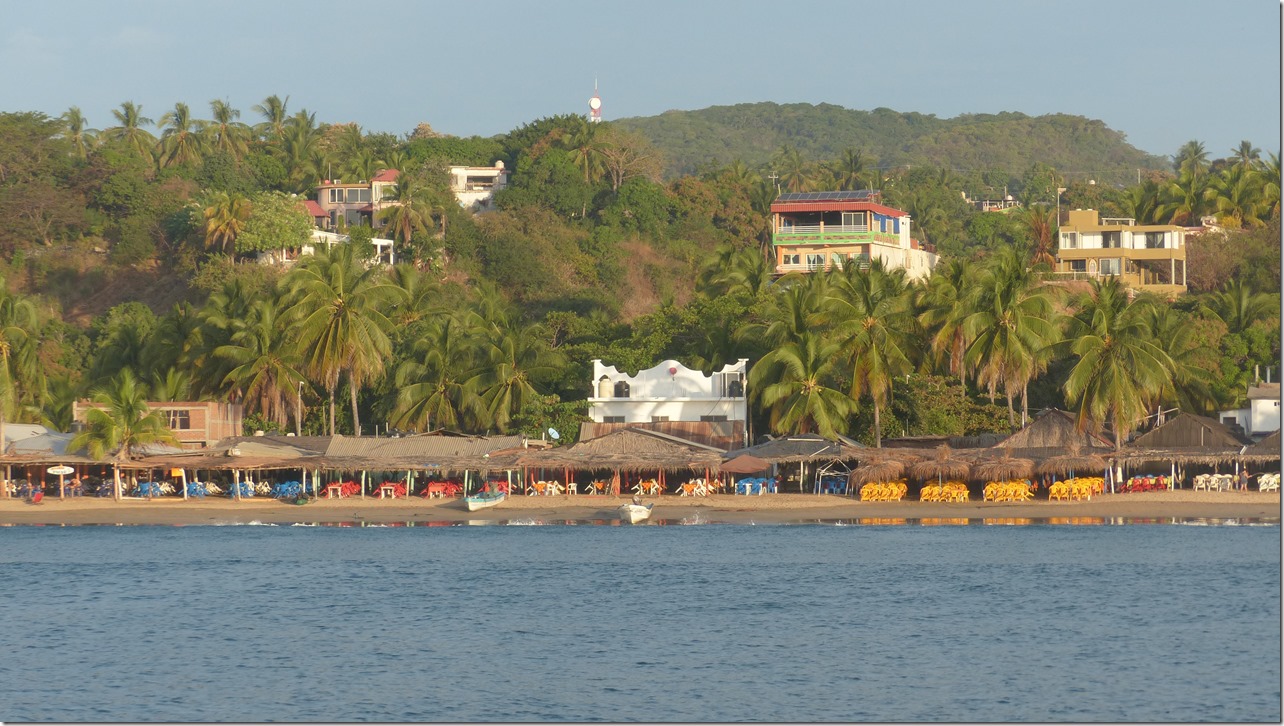
January 24th – Caleta de Campos
The next morning we left the beautiful Caleta de Campos at 08:00 taking advantage of some wind. So we set sails heading to Maruata, the next possible anchorage on the way, 36 nm NW. After a hour or so the wind disappeared, so we had to start the engine again; this is quite frustrating for several reasons: the noise, the prolonged use of the engine and the cost of the diesel. We motored for 7 hours with a constant speed of 5 knots. Though, it was not boring because of the beauty of the cost that is fringed by green mountains, full of cactus overarching long white sand beaches without any construction or presence of people.
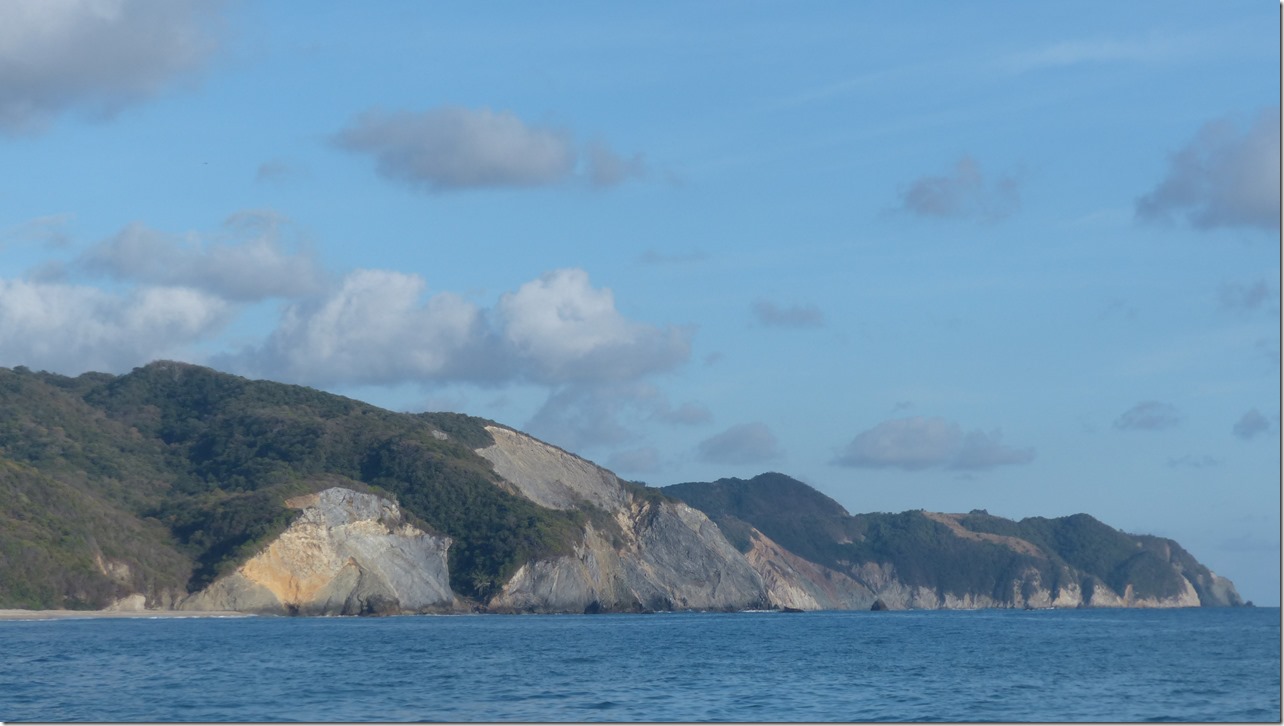
January 24th – On our way to Bahia de Maruata
After a couple of hours of navigation, we were surprised by the sudden appearance of a whale at about 50 meters from the boat: it was a very rapid move and we could only see the shiny back of the whale arching outside of the water and disappearing soon after. We were accompanied by several schools of dolphins and turtles that were coming to the surface to breath for a few seconds. In the afternoon, while approaching Maruata bay and seeking the place to anchor, we saw in a distance the spray of another whale and its silhouette on the water. We noticed that all the whales we spotted so far were heading South.
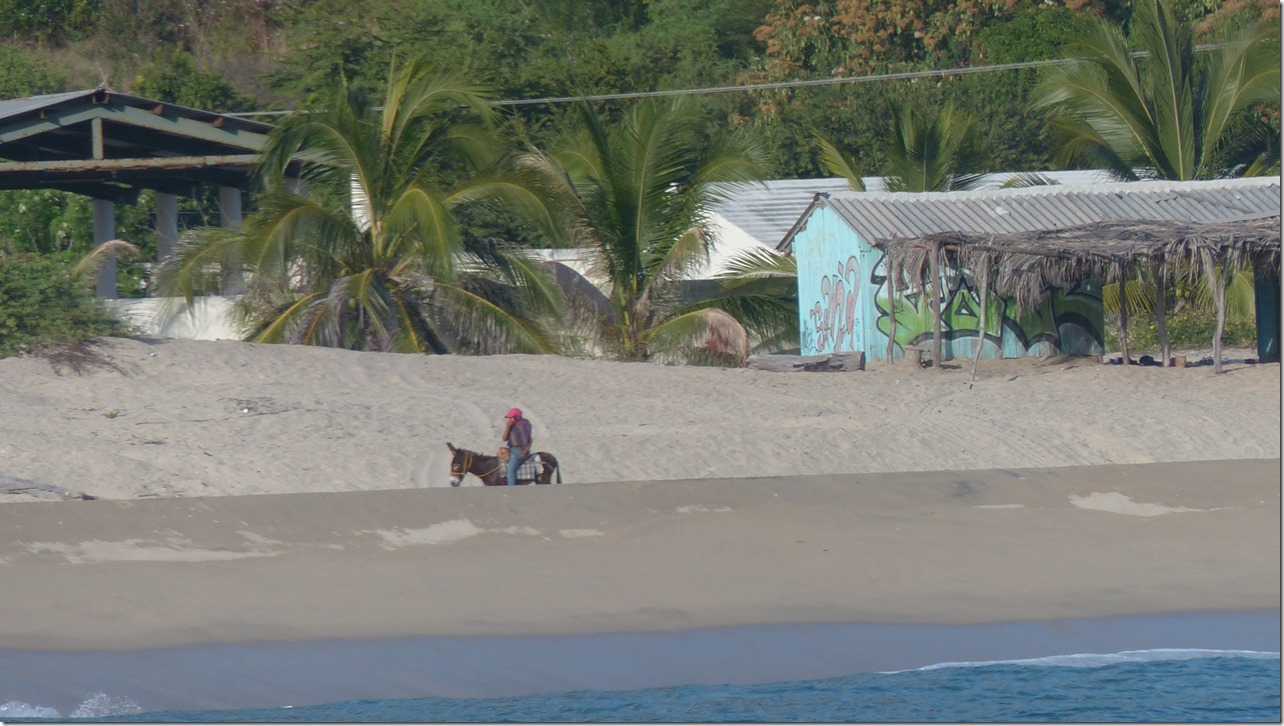
Januay 24th – Bahia de Maruata
Maruata bay is a beatiful place: a long white sand beach fringed by cabanas and small restaurants, surrounded by high cliffs on top of which there are some fisherman houses. The several dozens of pelicans were resting close to the beach, few of them busy with the last dives of the day while others were already flying to their sleeping sites, over trees or rocks. We were approached by two young local guys who canoed to our boat and explained us that in the bay they collect oysters, clams and several other kinds of “mariscos”.
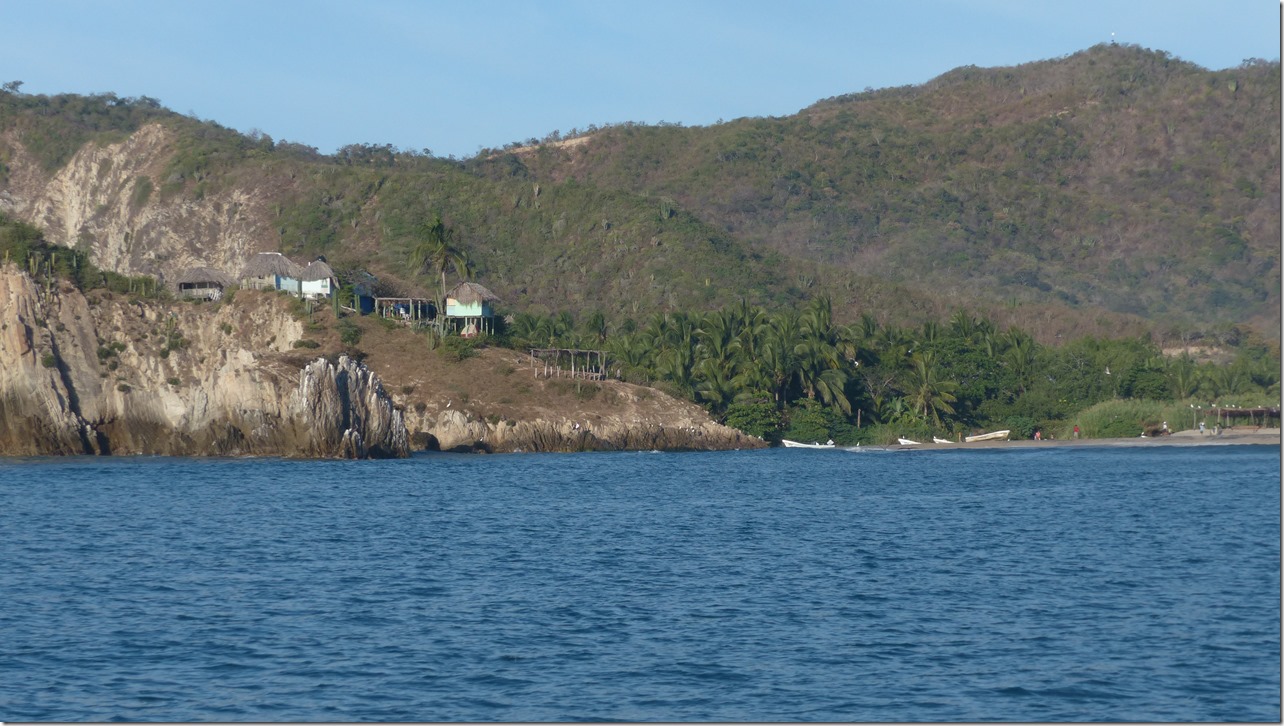
January 25th – Bahia de Maruata
In the morning we explored by dinghy the nearby coast, fringed by rocks of beautiful shapes, constantly hit and shaped by the waves and the wind. We were unable to land anywhere because in this part of the Mexican coast there are very few spots were the long Pacific waves do not break on the beach. And, in fact, you can often see local kids practicing surf on their rudimentary boards.
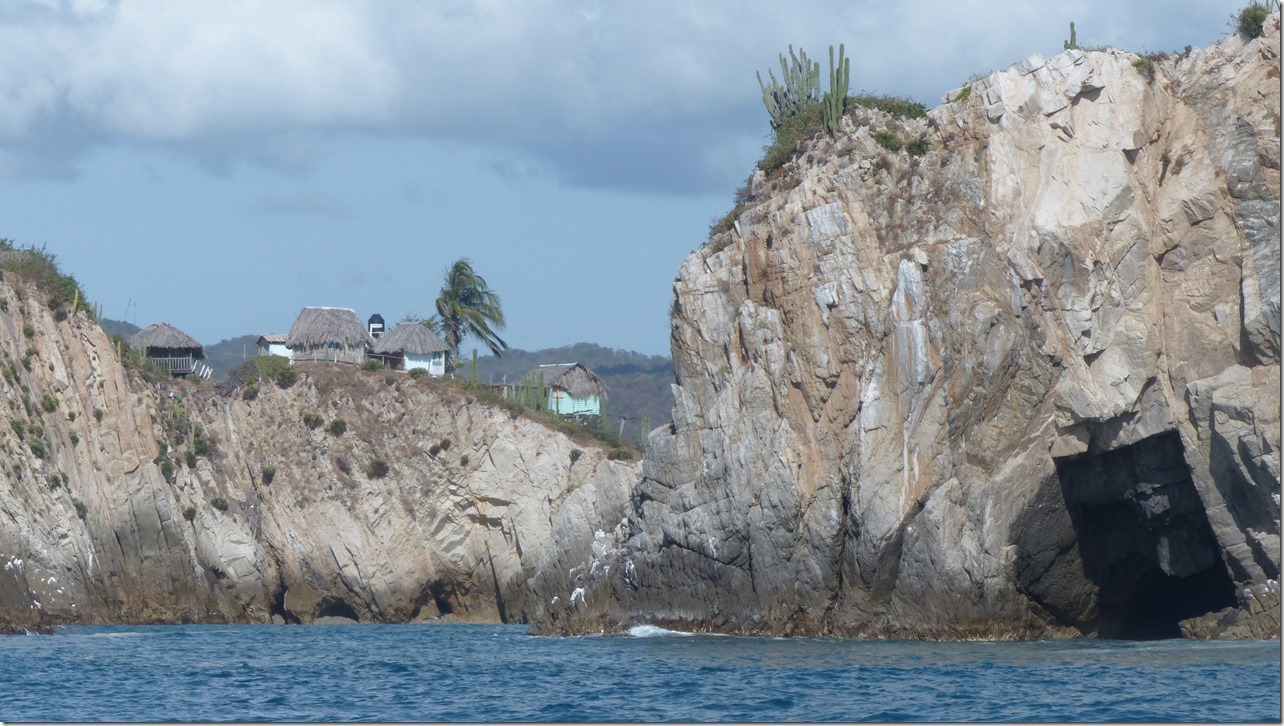
January 25th – Bahia de Maruata
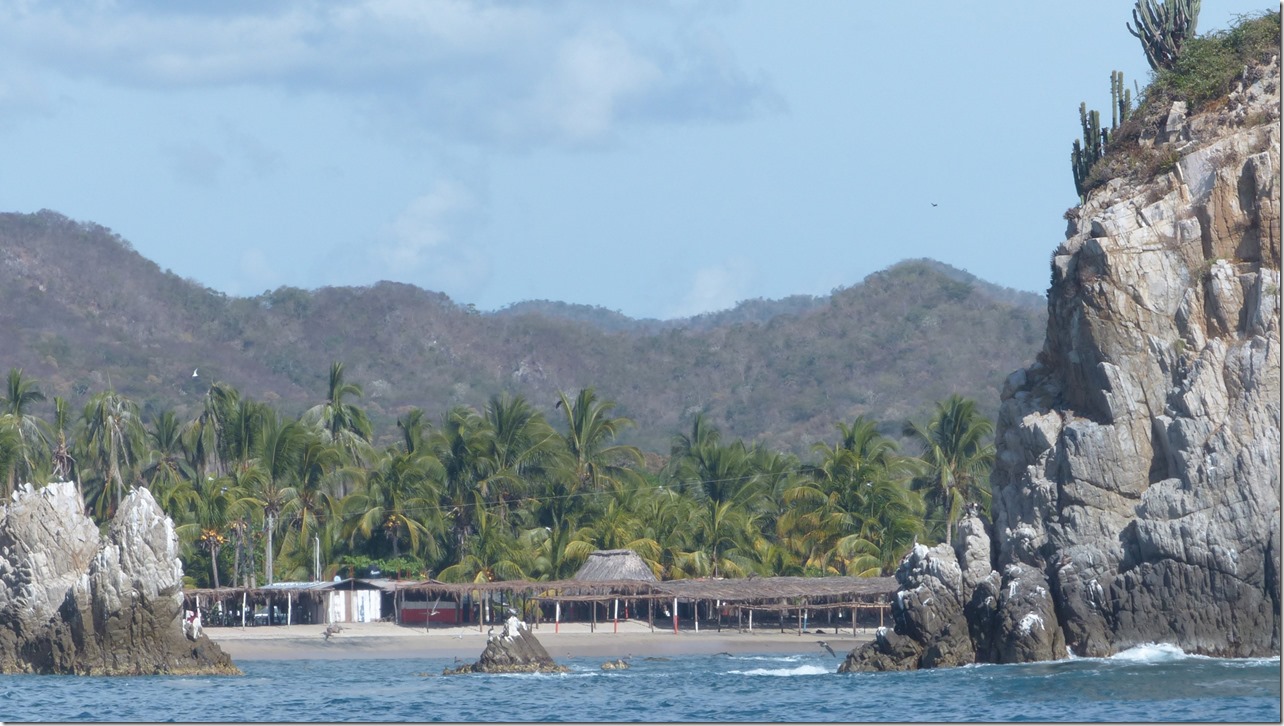
Around 10.30 some sort of wind (6-8 knots) made its appearance and convinced us to leave. For about 3 hours we sailed at an average speed of 2.5 knots, until the wind ceased completely and we motored till Punta San Telmo, about 10 nm from Maruata. We spotted two whales in the distance, one while we were anchoring.
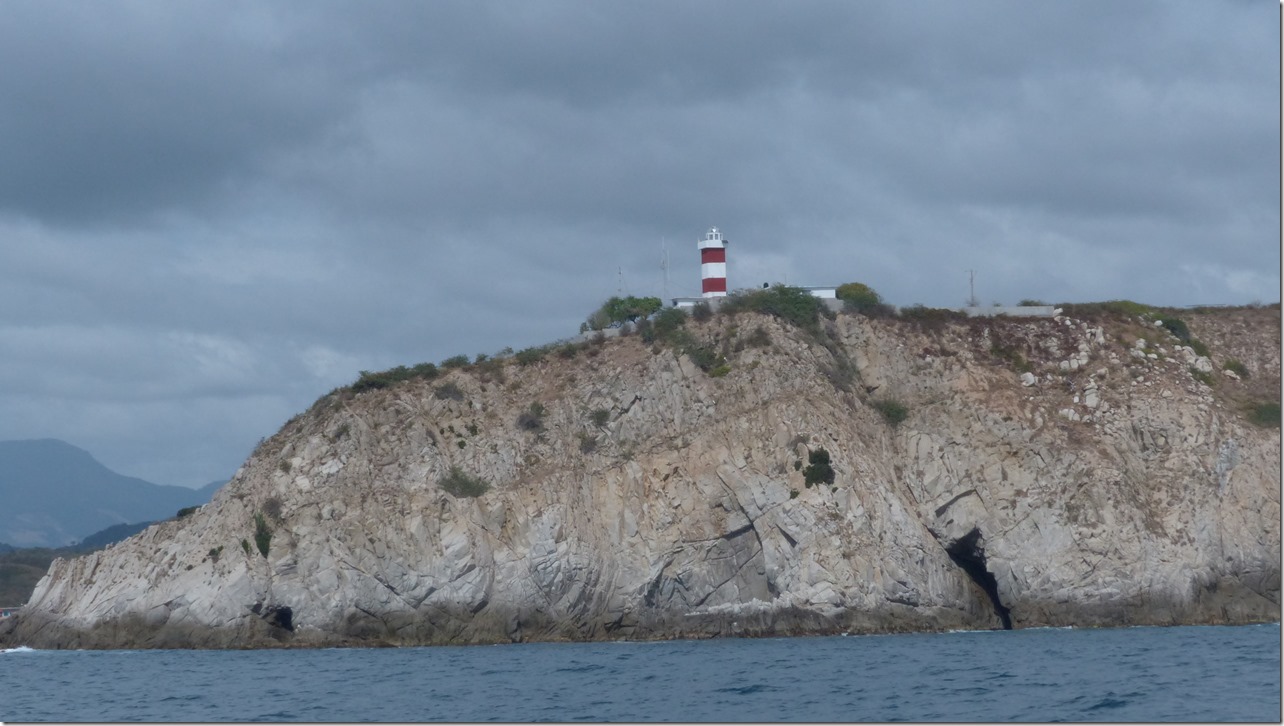
January 25th – Punta San Telmo
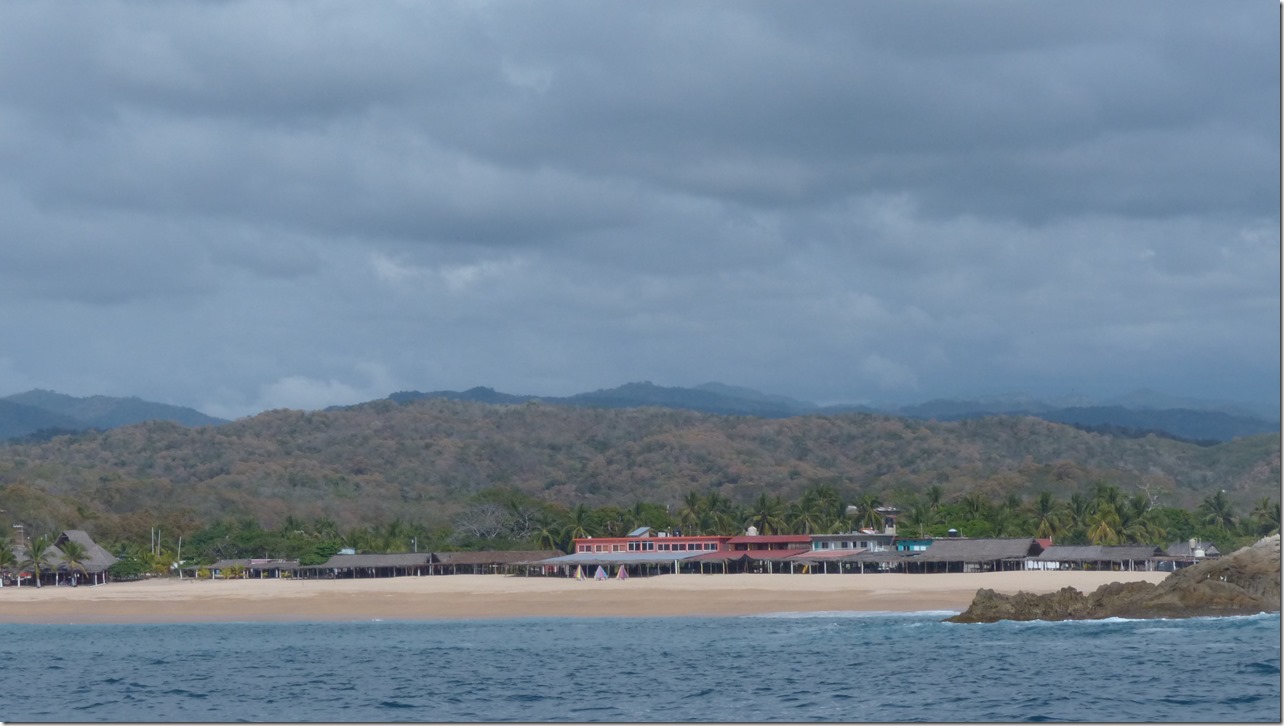
January 25th – Bahia San Telmo
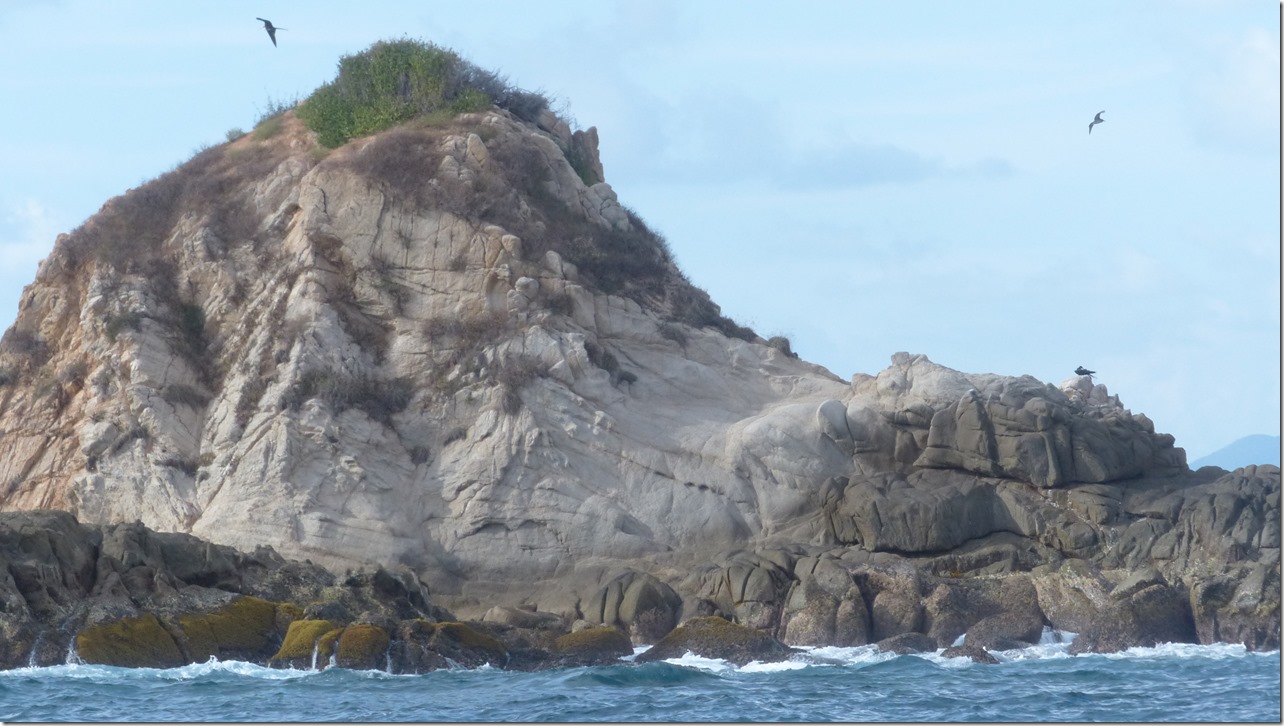
January 25th – Bahia San Telmo
On Sunday 26th we left Punta San Telmo to reach Punta Cabeza Negra, about 23 nm NW, and unfortunately we had to motor all the way up. Despite the ideal conditions for spotting whales, as we had the sun behind us and a totally flat sea, we did not encounter any.
We thought of some differences between the Atlantic and the Pacific ocean: curiously, when we were on the Atlantic we were very often approached by different species of birds such sulas, sternas, and even smaller birds, resting on the top of our bimini or on the solar panels getting a free ride. This has never happened so far in the Pacific where birds seem to be much less confident. Another peculiarity of the Atlantic were the numerous flying fishes, especially during the crossing – every morning we had a few of those on our deck. The only time when we had a fish coming on board was in Acapulco where we were waken up by a fish who centered the porthole and landed right under the table in the dinette. And of course a big difference between the two sides of Central America is the tide, almost nonexistent on the Atlantic side and very significant on the Pacific side (even if in Mexico the tide excursion is generally limited to about 1 meter, much less than in Panama or Costa Rica).
![2020-01-26 16.53.21 DMC-FZ200_thumb[1]_thumb 2020-01-26 16.53.21 DMC-FZ200_thumb[1]_thumb](https://www.sailoutofthebox.com/wp-content/uploads/2020/01/2020-01-26-16.53.21-dmc-fz200_thumb1_thumb_thumb.jpg)
January 26th – Punta Cabeza Negra
At 6.30 am we set sails to reach Manzanillo. The wind was favorable and for 45 minutes or so we sailed at 7 knots. but the calms were behind the door, despite the forecasts. For about 3 hours we slowly motored waiting for the 15 knots wind that was foreseen to be on our face. We took the chance to enjoy dozens of dolphins and turtles coming by our boat.
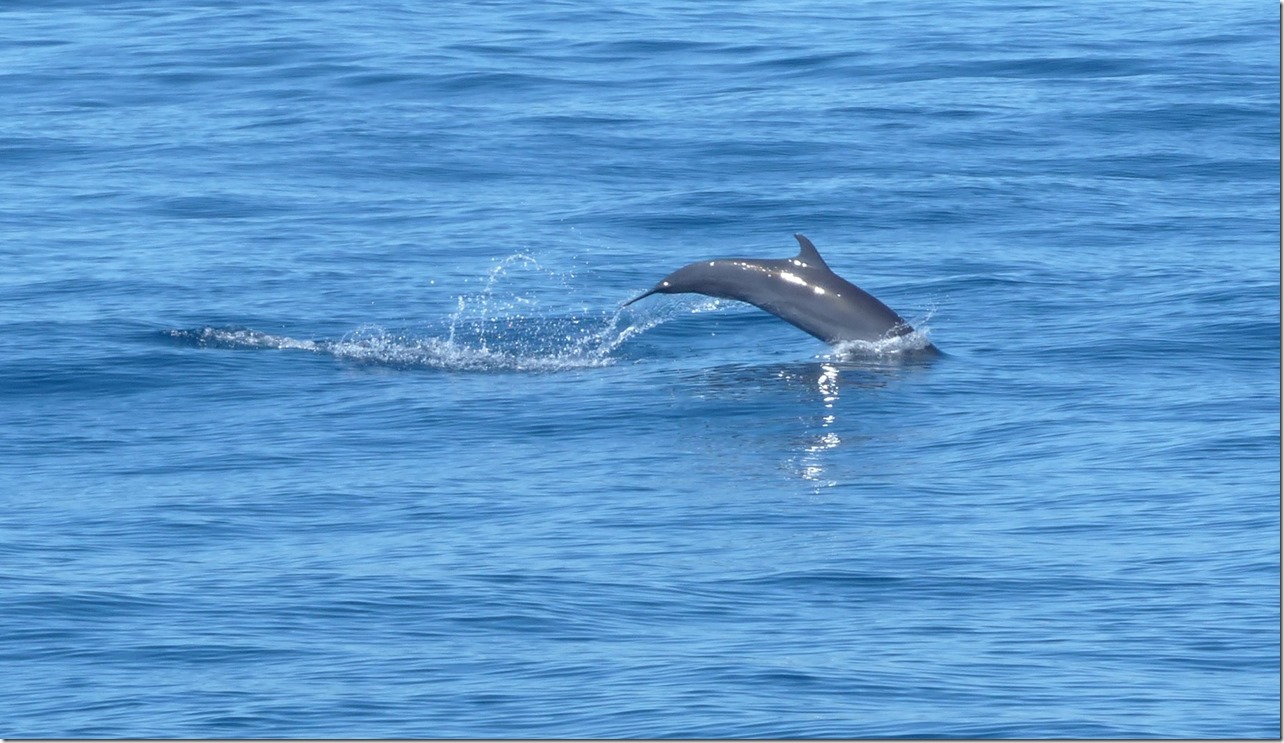

Around 12.30pm the forecasts became reality, and we finally started tacking to get to Manzanillo. The waves started building up, and we found that by sailing closer to the coast we could enjoy a calmer sea and higher speeds, but a worse wind angle (due to the Coriolis effect) – you can clearly see what we mean watching the curve in our track. As we wished to get to the anchorage with some daylight we decided to motor against the wind for two miles to cross the cape of the gulf of Manzanillo – motoring, and therefore having a flatter and a slower boat, gave us also the chance to bring on board in more comfortable conditions two tuna fishes we caught in the meanwhile. After we passed the cape of Manzanillo we sailed the last 5 miles at an average of 7 knots with a partially furled yankee and about 18 knots of wind at 60 degree. It was a wonderful horse ride. We got at the anchorage in the NW side of the Manzanillo bay right after sunset, perfectly on time to drop the anchor in the middle of a number of boats that were already enjoying this beautiful spot.
![2020-01-28 08.32.03 DMC-FZ200_thumb[1]_thumb 2020-01-28 08.32.03 DMC-FZ200_thumb[1]_thumb](https://www.sailoutofthebox.com/wp-content/uploads/2020/01/2020-01-28-08.32.03-dmc-fz200_thumb1_thumb_thumb.jpg)
January 28th – Waking up in the bay of Manzanillo
From Acapulco to Manzanillo
On January 9th we left Acapulco heading to Bahia Papanoa, a small harbor and village approximately 80 miles NW of Acapulco. We arrived in the late evening and we anchored in Playa Escondido opposite to the village of Papanoa. That was a nice and calm anchorage in front of the white sand beach. The day after we moved on the other side of the peninsula, in front of the village, where vacationers spend the weekend enjoying music, restaurants and water games. We spent about 4 days getting rid of a bad flu Sergio got while in Acapulco.
January 9th – Bahia Papanoa
On the 13th we left heading to Bahia de Petatlan where in the SE section of the bay is located a small village called Barra de Potosi. The name comes from the sand bar behind which there is a lagoon that is a wild life refuge, home to a lot of birds species.
January 13th – Barra de Potosi (right hand side)
On January 15th we motored to the bay of Zihuatenejo; we anchored close to the Playa Los Gatos, in the SE side of the bay.
January 15th – Rocas Potosi on our way to Zihuatenejo
We immediately realized that Zihuatenejo is a very alive and turistic city. In fact, the bay was crowded with sailing and power boats, and cruise ships as well!
January 15th – Playa Los Gatos is “behind” the catamaran
The day after we decided to anchor on the NW side of the bay, in front of the city dock. We landed the dinghy on the beach with the prompt help of local people who also offered to keep a watch on it. Zihua, as the local call their city, has a nice waterfront walk full of restaurants and shops for the hordes of tourists that fill up the city especially when cruise ships arrive.
January 16th – The waterfront of Zihuatenejo
We found a very well equipped supermarket for our routinely provisioning, which included a delicious camembert made in Mexico! We had a great lunch at Leo Mariscos that was recommended by Alison and Dave, a couple of fellow sailors and friends that we met a couple of years ago. After two days we moved back to Playa Los Gatos where we had a nice snorkelling session just twenty meters from the beach.
Few miles further North of Zihuatenejo lies Isla Grande, where we anchored for a couple of days and – on top of the usual snorkeling – we had the chance to get a relaxing 1 hour massage right on the beach.
January 18th – Isla Grande, Ixtapa
January 19th – Day tourists leaving Isla Grande
While there, we realized that the outboard engine had a problem with the impeller (the cooling water was not circulating), so we decided to get to the close by Marina Ixtapa to have someone help repairing it. The canal to get to the Marina is well marked, however we had to pass through a very narrow stretch of water which is often dredged to keep it clear from the sand that builds up.
January 20th – Entering the Marina Ixtapa
January 21st – Marina Ixtapa
The marina is managed by all women, including the harbour master who kindky welcomed us. It is a nice and comfortable marina with a great shuttle service to Ixtapa and Zihua. Ixtapa is the result of a goverment development project back in the 70s, concurrently with Cancun, but with very different results. In fact, in Ixtapa you can feel some sort of exclusivity and a relatively elegant set of buildings all along its very wide waterfront. We had the chance to visit a crocodile reserve, open to the public, just behind Playa Linda; we were amazed by the number and the size of these crocodiles and by the turtles and iguanas that were all sharing in peace the same habitat.
January 21st – Crocodiles reserve
January 21st – Iguana at the Crocodiles reserve
January 21st – Playa Linda
We were able to solve our engine issue thanks to a competent and quite inexpensive local mechanic. Having accomplished our main goal, it was time to leave continuing our trip to North West, heading to Caleta de Campos. Unfortunately it was again a trip dominated by the absence of wind, so we arrived late at night after slowly motoring the whole day.
January 23rd – Caleta de Campos
January 24th – Caleta de Campos
The next morning we left the beautiful Caleta de Campos at 08:00 taking advantage of some wind. So we set sails heading to Maruata, the next possible anchorage on the way, 36 nm NW. After a hour or so the wind disappeared, so we had to start the engine again; this is quite frustrating for several reasons: the noise, the prolonged use of the engine and the cost of the diesel. We motored for 7 hours with a constant speed of 5 knots. Though, it was not boring because of the beauty of the cost that is fringed by green mountains, full of cactus overarching long white sand beaches without any construction or presence of people.
January 24th – On our way to Bahia de Maruata
After a couple of hours of navigation, we were surprised by the sudden appearance of a whale at about 50 meters from the boat: it was a very rapid move and we could only see the shiny back of the whale arching outside of the water and disappearing soon after. We were accompanied by several schools of dolphins and turtles that were coming to the surface to breath for a few seconds. In the afternoon, while approaching Maruata bay and seeking the place to anchor, we saw in a distance the spray of another whale and its silhouette on the water. We noticed that all the whales we spotted so far were heading South.
Januay 24th – Bahia de Maruata
Maruata bay is a beatiful place: a long white sand beach fringed by cabanas and small restaurants, surrounded by high cliffs on top of which there are some fisherman houses. The several dozens of pelicans were resting close to the beach, few of them busy with the last dives of the day while others were already flying to their sleeping sites, over trees or rocks. We were approached by two young local guys who canoed to our boat and explained us that in the bay they collect oysters, clams and several other kinds of “mariscos”.
January 25th – Bahia de Maruata
In the morning we explored by dinghy the nearby coast, fringed by rocks of beautiful shapes, constantly hit and shaped by the waves and the wind. We were unable to land anywhere because in this part of the Mexican coast there are very few spots were the long Pacific waves do not break on the beach. And, in fact, you can often see local kids practicing surf on their rudimentary boards.
January 25th – Bahia de Maruata
Around 10.30 some sort of wind (6-8 knots) made its appearance and convinced us to leave. For about 3 hours we sailed at an average speed of 2.5 knots, until the wind ceased completely and we motored till Punta San Telmo, about 10 nm from Maruata. We spotted two whales in the distance, one while we were anchoring.
January 25th – Punta San Telmo
January 25th – Bahia San Telmo
January 25th – Bahia San Telmo
On Sunday 26th we left Punta San Telmo to reach Punta Cabeza Negra, about 23 nm NW, and unfortunately we had to motor all the way up. Despite the ideal conditions for spotting whales, as we had the sun behind us and a totally flat sea, we did not encounter any.
We thought of some differences between the Atlantic and the Pacific ocean: curiously, when we were on the Atlantic we were very often approached by different species of birds such sulas, sternas, and even smaller birds, resting on the top of our bimini or on the solar panels getting a free ride. This has never happened so far in the Pacific where birds seem to be much less confident. Another peculiarity of the Atlantic were the numerous flying fishes, especially during the crossing – every morning we had a few of those on our deck. The only time when we had a fish coming on board was in Acapulco where we were waken up by a fish who centered the porthole and landed right under the table in the dinette. And of course a big difference between the two sides of Central America is the tide, almost nonexistent on the Atlantic side and very significant on the Pacific side (even if in Mexico the tide excursion is generally limited to about 1 meter, much less than in Panama or Costa Rica).
January 26th – Punta Cabeza Negra
Around 12.30pm the forecasts became reality, and we finally started tacking to get to Manzanillo. The waves started building up, and we found that by sailing closer to the coast we could enjoy a calmer sea and higher speeds, but a worse wind angle (due to the Coriolis effect) – you can clearly see what we mean watching the curve in our track. As we wished to get to the anchorage with some daylight we decided to motor against the wind for two miles to cross the cape of the gulf of Manzanillo – motoring, and therefore having a flatter and a slower boat, gave us also the chance to bring on board in more comfortable conditions two tuna fishes we caught in the meanwhile. After we passed the cape of Manzanillo we sailed the last 5 miles at an average of 7 knots with a partially furled yankee and about 18 knots of wind at 60 degree. It was a wonderful horse ride. We got at the anchorage in the NW side of the Manzanillo bay right after sunset, perfectly on time to drop the anchor in the middle of a number of boats that were already enjoying this beautiful spot.
January 28th – Waking up in the bay of Manzanillo